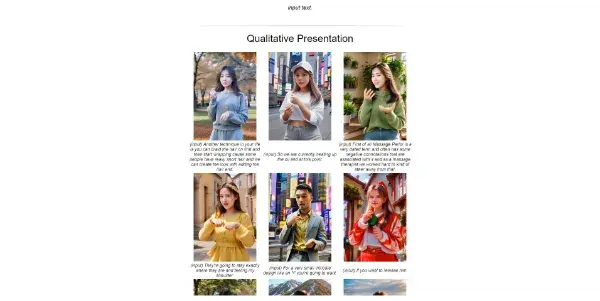SignLLM

A predictive LLM model for sign language. It translates text into realistic signs and promotes accessibility and inclusion for deaf people
SignLLM: Bridging the Communication Gap with AI-Powered Sign Language Translation
What is SignLLM?
SignLLM is a groundbreaking predictive Large Language Model (LLM) specifically designed for sign language. Unlike general-purpose LLMs, SignLLM focuses on translating written text into realistic and accurate sign language representations. This innovative tool aims to significantly improve accessibility and inclusion for Deaf and hard-of-hearing individuals by bridging the communication gap between the hearing and Deaf communities. It achieves this by generating video output depicting a virtual avatar signing the inputted text.
Main Features and Benefits
SignLLM offers several key features and benefits:
- Text-to-Sign Translation: The core functionality is its ability to accurately translate written text into sign language videos. This eliminates the need for human interpreters in many situations.
- Realistic Sign Language Generation: The model strives for natural and nuanced sign language, avoiding stilted or robotic movements often seen in earlier attempts at automated sign language generation. The avatar's movements are intended to be fluid and expressive.
- Accessibility: SignLLM dramatically improves communication accessibility for Deaf and hard-of-hearing individuals, making information and services more readily available.
- Inclusion: By fostering better communication, SignLLM promotes greater inclusion of Deaf individuals in various aspects of society.
- Multilingual Support (Potential): While the current scope may be limited, future versions could potentially support multiple sign languages, significantly expanding its reach.
Use Cases and Applications
SignLLM possesses a wide range of potential applications:
- Education: Creating accessible educational materials for Deaf students, including lectures, tutorials, and instructional videos.
- Healthcare: Improving communication between healthcare providers and Deaf patients, leading to better diagnosis and treatment.
- Customer Service: Providing sign language support for customer service interactions, enhancing accessibility for Deaf customers.
- Public Service Announcements: Generating sign language versions of important public announcements and safety information.
- Accessibility for the Deaf Community: Creating subtitles for videos and providing accessible information for those who rely primarily on sign language.
- Language Learning: SignLLM could aid in learning sign language by providing visual feedback on user's signing attempts (though this is not a currently implemented feature)
Comparison to Similar Tools
While SignLLM is a relatively new entrant, it stands apart from existing sign language translation tools by focusing on the generation of realistic and nuanced sign language videos. Many existing tools may offer text-to-sign translation but lack the sophisticated rendering of natural signing movements provided by SignLLM. A direct comparison requires specifying other tools; however, a key differentiator is the emphasis on realistic avatar movement and less emphasis on simpler, less natural sign representations.
Pricing Information
SignLLM is currently offered free of charge. This open and accessible approach contributes significantly to its potential impact on the Deaf community. However, the future pricing model may change as the tool develops and scales.
Conclusion
SignLLM represents a significant advancement in assistive technology for the Deaf community. Its ability to translate text into realistic sign language videos has the potential to revolutionize communication and improve accessibility in various sectors. As the model continues to develop and expand its capabilities, it promises to play an increasingly important role in fostering inclusion and breaking down communication barriers.